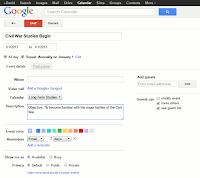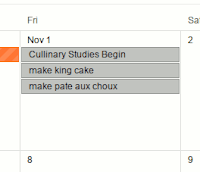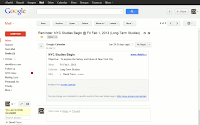This article defines my GTD-inspired technique for managing long-term studies. It begins by helping you define your long-term study projects, then describes a method for scheduling those projects and achieving your learning goals. It uses Google Calendar for scheduling examples.
Identifying Long-Term StudiesAs this technique applies only to long-term studies, we first need to define a long-term study.
Long-term studies involve broad topics and take a sizable amount of time to complete. For example, a topic such as "learn the minor scales" is not a long-term study, but "music theory" is. In general, if you can envision yourself studying a topic for at least three more years, it could be one of your long-term studies.
You may find that many of your long-term studies are outside the realm of your occupation, although some of them can be tangentially related to your professional work. A surgeon interested in the long-term study of World War II and Ancient Egypt certainly won't be dedicating time to those studies in the operating room. Knowledge, however, is an interrelated web, so when that surgeon comes across medical advancements made during World War II or the Ancient Egyptians' nascent forays into surgery, the study becomes occupation-related.
Long-term studies are also not dependent on a strict deadline; they are much more open-ended with respect to time. So, if you are a computer programmer and your manager informed you that in two months your department will be starting a project written in Google's new programming language called "Go", learning Go will become one of your study projects (assuming you want to keep your job). But "learn Go" is not a long-term study and it doesn't belong in this program (although some of the techniques in this method can be applied to learning anything). You'll find that many of your long-term studies will be lifelong endeavors. For example, "Ancient Egyptian studies" may be something you engage in for the rest of your life.
I also don't include continual studies in this program. For example, I spend 20 minutes every day working on my French, but not all of the technique described here helps me with this. If you have similar studies, you'll probably want to manage those studies outside this plan.
Here are just a few examples of long-term studies that could be managed using this technique:
Write Your ObjectivesOnce you have identified your long-term studies, you must write an objective for each. Don't assume you know what your objectives are; you must commit them to words and record those words on paper or in your computer. You might be surprised at how empowering a well-constructed objective can be. For example, suppose one of your long-term studies is "learn French". Defining your objective as "to be able to read Voltaire's Candide in French" specifies a tangible goal that can provide you with additional motivation in learning the language. Like all of this method, nothing is carved in stone and you can replace objectives as appropriate. Once you finish reading Candide, you might want to replace the objective with "to be able to carry on a conversation with a native French speaker without hesitation."
Your objectives should not be too short-term. Take care to define your objectives broadly enough so that you don't waste your time revising them every few days or weeks. If you are studying music theory, "master the scales of Western music and be able to identify them by ear" might be a good objective, but "be able to identify the descending melodic minor scale" is too fine-grained.
CapturingSince the journey of a learner is like a spider exploring one giant web, you'll find that as you work on a long-term study or any other activity, thoughts and objects that apply to your other study topics will inevitably cross your path. For example, you could be working on your conversational French when you come across a recipe for pate aux choux that you want to try making the next time you are scheduled to study culinary arts. You will lose efficiency if you shift context and begin working in an area outside of the current task. So, you need a good capture system that allows you to quickly and reliably categorize and store these thoughts and objects, then forget about them so you can dedicate full attention to your task at hand.
The topic of capture devices is beyond the scope of this article, but I'll touch a bit on the concept to get you started. Your capture devices may differ based on what you are capturing. For example, if you study Native American culture, and you come across an artifact you'd like to study, you'll need a box or shelf to stash away the objects until your schedule allows you to address it. If it's a to-do that crosses your mind, you may want to capture it in software such as Remember the Milk. If it's a Web page or PDF file that you'll need to read when its long-term study period begins, you may want to store it in a digital notebook such as Evernote. If it's a book you need to read, Zotero might be the solution.
The devices you employ in your capture system must be reliable and efficient. They must allow you to quickly categorize the objects into their long-term study area and retain all of your materials so that you know they will be there when it comes time to address them. You'll need to experiment to see which tools work best for you, but that experimentation will be time well spent.
Mapping Studies to Time Periods
Once you've decided what you will be studying, you need to create a study schedule. You'll be carving up your year in a way that allows you to meet all of your study objectives, breaking down the year by month or other discrete period of time (e.g., fortnight, week, quarter of a year). I like to focus on a month at a time, assigning a topic to each month, but you do not have to use equal time periods for each study topic. "Elizabethan theater studies" might get a two month slot while "culinary arts" might receive only two weeks.
Calendar: Mandatory
Once you've carved up your year, you must record your schedule on a calendar. This tutorial uses Google Calendar as that is the tool I use to implement this technique. You should be able to use any software calendar that meets the requirements below.- Identifying Long-Term Studies
- Writing Your Objectives
- Capturing
- Mapping Studies to Time Periods
- Calendar: Mandatory
- When Your 7-Day Preparation Alert Arrives
- Reviewing the Study Plan
Identifying Long-Term Studies
Long-term studies involve broad topics and take a sizable amount of time to complete. For example, a topic such as "learn the minor scales" is not a long-term study, but "music theory" is. In general, if you can envision yourself studying a topic for at least three more years, it could be one of your long-term studies.
You may find that many of your long-term studies are outside the realm of your occupation, although some of them can be tangentially related to your professional work. A surgeon interested in the long-term study of World War II and Ancient Egypt certainly won't be dedicating time to those studies in the operating room. Knowledge, however, is an interrelated web, so when that surgeon comes across medical advancements made during World War II or the Ancient Egyptians' nascent forays into surgery, the study becomes occupation-related.
Long-term studies are also not dependent on a strict deadline; they are much more open-ended with respect to time. So, if you are a computer programmer and your manager informed you that in two months your department will be starting a project written in Google's new programming language called "Go", learning Go will become one of your study projects (assuming you want to keep your job). But "learn Go" is not a long-term study and it doesn't belong in this program (although some of the techniques in this method can be applied to learning anything). You'll find that many of your long-term studies will be lifelong endeavors. For example, "Ancient Egyptian studies" may be something you engage in for the rest of your life.
I also don't include continual studies in this program. For example, I spend 20 minutes every day working on my French, but not all of the technique described here helps me with this. If you have similar studies, you'll probably want to manage those studies outside this plan.
Here are just a few examples of long-term studies that could be managed using this technique:
- self-improvement studies
- New York City studies
- media studies
- applied English studies
- linguistics
- political science
- Elizabethan theater studies
- general theater studies
- criminology
- culinary arts
- religion and belief systems
Write Your Objectives
Your objectives should not be too short-term. Take care to define your objectives broadly enough so that you don't waste your time revising them every few days or weeks. If you are studying music theory, "master the scales of Western music and be able to identify them by ear" might be a good objective, but "be able to identify the descending melodic minor scale" is too fine-grained.
Capturing
The topic of capture devices is beyond the scope of this article, but I'll touch a bit on the concept to get you started. Your capture devices may differ based on what you are capturing. For example, if you study Native American culture, and you come across an artifact you'd like to study, you'll need a box or shelf to stash away the objects until your schedule allows you to address it. If it's a to-do that crosses your mind, you may want to capture it in software such as Remember the Milk. If it's a Web page or PDF file that you'll need to read when its long-term study period begins, you may want to store it in a digital notebook such as Evernote. If it's a book you need to read, Zotero might be the solution.
The devices you employ in your capture system must be reliable and efficient. They must allow you to quickly categorize the objects into their long-term study area and retain all of your materials so that you know they will be there when it comes time to address them. You'll need to experiment to see which tools work best for you, but that experimentation will be time well spent.
Mapping Studies to Time Periods
 |
| Adding a new calendar |
Calendar: Mandatory
 |
| Creating event for start of a study period |
 |
| Actions on calendar |
When Your 7-Day Preparation Alert Arrives
 |
| Example of email reminder |
Each activity must be broken down into actions. Actions are the nitty-gritty tasks that, once performed, complete your activity. Sticking with our culinary arts example, if you need flour for your pate aux choux, an action is "buy flour". If your oven is broken, an action is "schedule oven repair". If you need to obtain a good cookbook with pate aux choux recipes, the action will be "request the cookbook from the library". At the end of your seven-day lead time, all of your actions should be defined and captured, and in the case of actions that require you to wait for others to perform some work (such as requesting library books), you might have already put some of these actions in-process.
Breaking down an activity into its actions is a balancing act. The difficulty is in making them specific enough so that you fully understand what you need to do, but not overly specific to the point that they are trivial. For example, if you need to purchase three books from Amazon.com, you may find recording three actions, "order book X", "order book Y" and "order book Z", is optimal. You could go completely overboard and record such actions as "turn on computer", "open Web browser", "navigate to Amazon.com"..., but that would be time consuming and ridiculous. In the other extreme, you could get lazy and record your action as "order all books necessary for study period", but then you open yourself up to forgetting one or more titles. Over time, as you gain experience in breaking activities into actions, you will find your optimal approach.
 |
| From the long-term study we determine an objective. The objective gives us activities and the activities determine actions. |
When your study period begins, start executing your actions. Each time you finish an action, experience the thrill of success by marking it complete.
Reviewing the Study Plan
I recommend reviewing your plan no less than twice a year. Schedule at least 30 minutes to review how well you are doing in your long-term studies. While you review, remember that nothing is carved in stone. What worked for a few years might not be working now, so change it. Only you will know, by your performance, if you are meeting the objectives you set out for yourself.
Be honest with yourself and experiment within this method...it's all a learning journey.